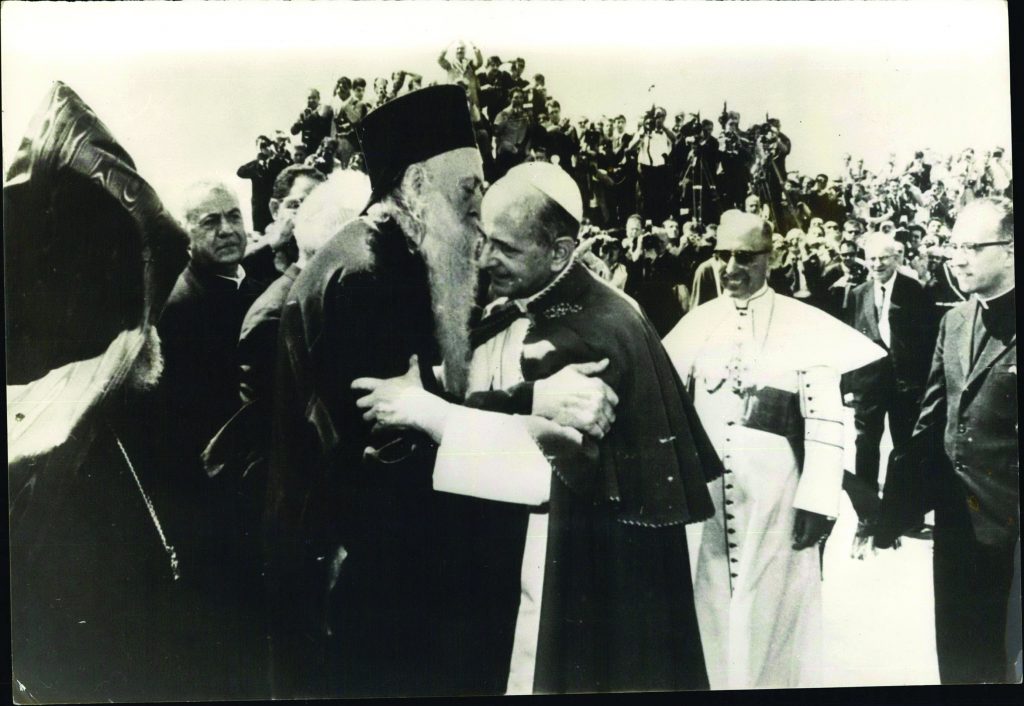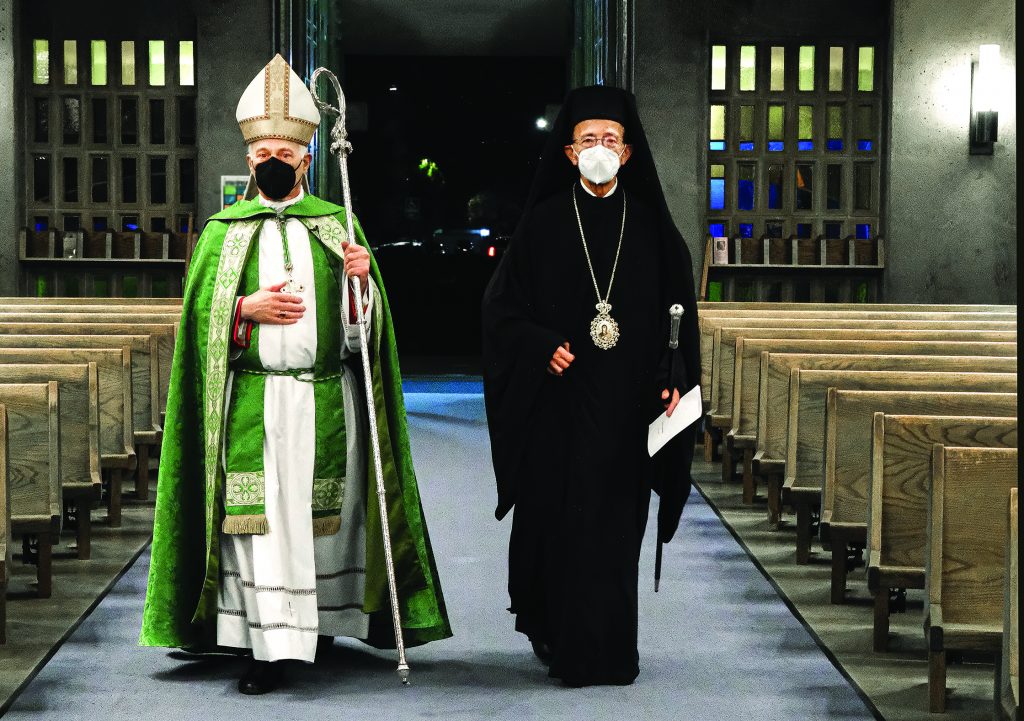ECUMENISM
Orthodox-Catholic friendship
Bonds of brotherhood, bonds of faith
By Father Kevin Kennedy
According to the New Testament (Mt 4:18-20, Mk 1:16-20), Jesus saw two fishermen, Simon Peter and his brother Andrew, walking along the Sea of Galilee. He said to them, “Come, follow me.” They immediately left their nets and followed him.
The Gospel of John tells the story of a different encounter. In this version two disciples of John the Baptist, Andrew and, traditionally, John, the son of Zebedee, heard John the Baptist refer to Jesus as the “Lamb of God.” These two disciples then followed Jesus and spent the day with him. Andrew, convinced that Jesus was the Christ, told his brother Simon, “We have found the Messiah.” He brought his brother to Jesus who revealed that Simon would be known as Peter (Jn 1:35-42). Afterward, both Andrew and Simon Peter left all things to become disciples of Jesus.
John the Baptist’s testimony made Andrew believe, and he then became a witness for his brother Simon. These narratives make clear that two brothers had an extraordinary encounter with Jesus that quickly and completely changed their lives.
Both Andrew and Peter would become missionary apostles and martyrs. Within Byzantine Christianity, St. Andrew is referred to as “the first called.” According to Orthodox tradition, the apostolic successor of St. Andrew is the patriarch of Constantinople, just as the apostolic successor of St. Peter is the bishop of Rome. There is an ancient and beautiful icon depicting the two saints embracing each other with fraternal love. Each brother has his own personality, charism and distinct mission; nevertheless they are one in their following of the Lord.
For the first 1,000 years of Christianity, the Church remained essentially united throughout the Eastern and Western parts of the Roman Empire. However, by the middle of the 11th century, for reasons as much cultural/political as theological, the sees (particular churches) of Rome and Constantinople were no longer in full communion. What a tragedy! It was as if a family had become divided because two brothers no longer understood one another, no longer trusted one another and were no longer speaking to one another. The icon of Andrew and Peter seemed to have been broken in two.
Catholicism and Orthodoxy efforts toward unity
For centuries, despite various attempts to reestablish full ecclesial unity, Catholicism and Orthodoxy have remained divided.
However, on Oct. 11, 1962, Pope St. John XXIII opened the Second Vatican Council which awakened new hopes for the future. On Nov. 21, 1964, his successor, Pope St. Paul VI, and the council fathers promulgated the Decree on Ecumenism, the first sentence of which stated: “The restoration of unity among all Christians is one of the principal concerns of the Second Vatican Council.”
At the beginning of that same year (Jan. 5-6, 1964), Pope Paul traveled to the Holy Land. His pilgrimage included a visit to the Sea of Galilee and a historic encounter with Athenagoras, the patriarch of Constantinople, during which they both sought to repair the broken “icon” (fraternal love) of Andrew and Peter by embracing and exchanging the kiss of peace.

With a special focus on Eastern Christianity, the Second Vatican Council’s Decree on Ecumenism stated: “It must not be forgotten that from the beginning the Churches of the East have had a treasury from which the Western Church has drawn extensively – in liturgical practice, spiritual tradition and law. Nor must we undervalue the fact that it was the ecumenical councils held in the East that defined the basic dogmas of the Christian faith, on the Trinity, on the word of God who took on flesh of the Virgin Mary. To preserve this faith these churches have suffered and still suffer much.” (Decree on Ecumenism, No. 14).
The decree went on to say: “The very rich liturgical and spiritual heritage of the Eastern Churches should be known, venerated, preserved and cherished by all. They must recognize that this is of supreme importance for the faithful preservation of the fullness of Christian tradition, and for bringing about reconciliation between Eastern and Western Churches.” (Decree on Ecumenism, No. 15).
Since 1964 a succession of Roman Catholic popes and Eastern Orthodox patriarchs have met and shared together in prayer, exchange of gifts and pledges to continue international theological discussions toward reaching the goal of full ecclesial communion. All of these encounters and efforts have been guided by
the Holy Spirit who enables us to respond to the prayer of Christ the Lord: “I ask not only on behalf of these, but also on behalf of those who will believe in me through their word, that they may all be one. As you, Father, are in me and I am in you, may they also be in us, so that the world may believe that you have sent me.” (Jn 17: 20-22).
At the same time, the Holy Spirit has birthed and nurtured encounters not just at international levels, but also and especially within local communities. In two San Mateo County parishes, one Roman Catholic and the other Greek Orthodox, outstanding examples of ecumenism can be found not just in theory but in practice. Father Peter Salmas, pastor of Holy Cross Greek Orthodox Church in Belmont, and Father Stephen H. Howell, pastor (emeritus) of Immaculate Heart of Mary Church in Belmont (now vicar general of the Archdiocese of San Francisco), built upon and greatly expanded the gestures of friendship and mutual cooperation between their parishes that have characterized those communities for decades.
Holy Spirit works locally
In recent years, this sharing of common prayer, service and friendship has expanded to a broader level as Metropolitan Gerasimos of San Francisco, the metropolitan bishop of the Greek Orthodox Metropolis of

San Francisco, and Archbishop Salvatore Cordileone, the archbishop of the Metropolitan Roman Catholic Archdiocese of San Francisco, have frequently met for prayer, dialogue and mutual support. In part two of this series we will examine more closely the story of the ecumenical bonds of friendship between these pastors and shepherds of Christ’s flock who are symbolically restoring the icon of two brothers in the midst of the apostles, St. Peter and St. Andrew.
Father Kevin Kennedy is pastor of Our Lady of Fatima Russian Byzantine Catholic Church, administrator at St. Monica-St. Thomas the Apostle Parish in San Francisco and formation adviser and spiritual director at St. Patrick’s Seminary & University.

